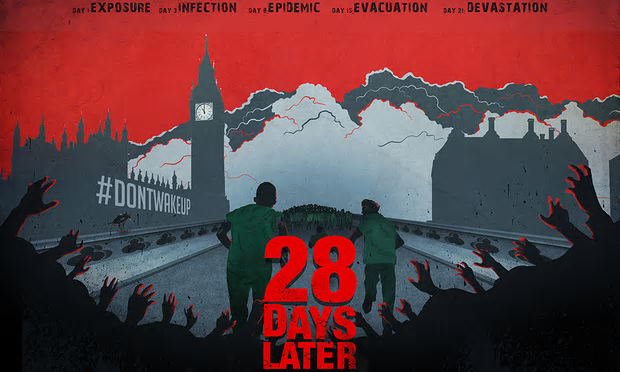Secret Cinema: Hybrid Theatre and Performing Dystopias by Dr Joseph Dunne
 Inspired by a conversation he had with scholars at the University of Malta on issues pertaining to immersive and participatory theatre practices, Joseph is writing an article for publication to a major journal discussing the aesthetics of immersive performance-screenings. Secret Cinema create three-dimensional cinematic worlds of popular movies at secret locations across London. Past events have included Back to the Future, Star Wars, Ghostbusters, Who Framed Roger Rabbit? and One Flew Over the Cuckoo’s Nest. In its early years, Secret Cinema only revealed what film was being performed-screened after one had purchased a ticket, a process that embodies Tim Etchells’ formulation of the contract between audience and actors as a process of “risk and investment”.
Inspired by a conversation he had with scholars at the University of Malta on issues pertaining to immersive and participatory theatre practices, Joseph is writing an article for publication to a major journal discussing the aesthetics of immersive performance-screenings. Secret Cinema create three-dimensional cinematic worlds of popular movies at secret locations across London. Past events have included Back to the Future, Star Wars, Ghostbusters, Who Framed Roger Rabbit? and One Flew Over the Cuckoo’s Nest. In its early years, Secret Cinema only revealed what film was being performed-screened after one had purchased a ticket, a process that embodies Tim Etchells’ formulation of the contract between audience and actors as a process of “risk and investment”.
Their latest showing is Danny Boyles’s 2002 sci-fi horror film 28 Days Later. A man wakes up in hospital to find that Britain has been overwhelmed by a rage virus, rendering all who come into contact with the infected as barbaric zombies who roam the country and attack all in their path. The story follows Jim’s and fellow survivors’ attempts to find refuge with an army unit, only to discover that the officer in charge intends to use the women as sex slaves to maintain discipline and morale amongst his troops.
Soon after purchasing his ticket Joseph received an email from Dr Louis Chambers from St Thomas’ Hospital (the hospital Jim wakes up in at the start of the film). She was writing to inform Joseph that he had been selected for vaccination against the virus and was told to go to a vaccination centre in Surrey Quays. He was directed to the NSH website where he found several film clips from the fictional news service RBC. The newsreader tells us that the rage virus is a mutation of a pathogen designed to combat the Ebola outbreak. Whilst being interviewed Dr Louise Chambers lays the blame to combat the outbreak squarely with the government’s intransigence over the introduction of new contracts for junior doctors and the resultant strike action.
Joseph’s interest in Secret Cinema is in the contract the company establish with audiences and the ways the performance-screenings fuse elements of the cinematic and the theatrical. In order to deepen their immersion in the event, audience members are required to purchase an anti-contamination kit, comprised of medical scrubs, a blood sample, bandages, a face mask, and a wristband. When he arrived at Canada Water station Joseph began to spot other audience members in the surrounding area, creating a sense of unspoken communality and excitement. The online elements and the costumes provoke the question as to when 28 Days Later starts, and indeed how many manifestations it exists in.

Joseph is drawing on Professor Frank Camilleri’s conception of hybridity as described in his article ‘Of Hybrids and the Posthuman: Performer Training in the 21st Century’ (2015) to develop a theoretical model elucidating the fusion of the online, cinematic and theatrical. Joseph is arguing that the world of 28 Days Later is partially created by igniting a dystopic atmosphere in the minds of the audience by using news footage depicting scenes of destruction, chaos, and state oppression. His article will also discuss how social media is used to establish contracts with audiences and what the terms and conditions of this contract are.
****
Towards a New Model of Peer Review by Dr Luis Campos
 The four members of teaching staff on the European Theatre Arts Programme (ETA) have just concluded an innovative approach to peer observation and reviewing. During the Practical Dissertation Projects each lecturer observed another whilst they were giving feedback to the Level 6 students. Now that the projects have concluded they will meet to share and reflect upon their observations, focusing particularly on the ways lecturers’ aid students in articulating their research questions through performance and, conversely, how practical exploration informs their theoretical inquiries. A general observation Luis has made is that each of his colleagues bridged formative and summative assessments, meaning they were all responding to what they were seeing in the studio by providing very specific and detailed feedback, whilst also linking the development of the performance to the overall aims and objectives of the research project.
The four members of teaching staff on the European Theatre Arts Programme (ETA) have just concluded an innovative approach to peer observation and reviewing. During the Practical Dissertation Projects each lecturer observed another whilst they were giving feedback to the Level 6 students. Now that the projects have concluded they will meet to share and reflect upon their observations, focusing particularly on the ways lecturers’ aid students in articulating their research questions through performance and, conversely, how practical exploration informs their theoretical inquiries. A general observation Luis has made is that each of his colleagues bridged formative and summative assessments, meaning they were all responding to what they were seeing in the studio by providing very specific and detailed feedback, whilst also linking the development of the performance to the overall aims and objectives of the research project.
If the model is considered to have been successful then there is the possibility that it could be expanded across programmes in both schools. This approach has the potential to formally address how research in College is developing as part of taught curricula and the ways in which teaching practice is responding in terms of methodological approaches and programme content. Moreover, this method of peer review has the potential to coordinate a methodology of skills amongst teaching staff and to identify any components that are missing from the available skill set.
****
DECODER or Digital Entry & Connections – Old Dramaturgical Experiences Revisited by Anna Makrzanowska
Since 2015, Anna has been conducting an examination into the contemporary methodologies involved in  the transmission process of past theatrical experiences. Her inquiry focuses specifically on Tadeusz Kantor’s practice and Cricot2 Theatre’s approach to devising. A series of research events including interviews, rehearsals, installations, live art, theatre shows, workshops, screenings, lectures, presentations and discussions were staged during the current academic year under the umbrella title Kantor Is Here. The main presentations were held at the 2016 Symposium.
the transmission process of past theatrical experiences. Her inquiry focuses specifically on Tadeusz Kantor’s practice and Cricot2 Theatre’s approach to devising. A series of research events including interviews, rehearsals, installations, live art, theatre shows, workshops, screenings, lectures, presentations and discussions were staged during the current academic year under the umbrella title Kantor Is Here. The main presentations were held at the 2016 Symposium.
Anna led a workshop-demonstration at the 2016 Symposium with performers from Rose Bruford and Royal Holloway entitled The Bio-Screen and Bio-Camera – Experimental Rehearsal Techniques, where she proposed the use of digital technologies as a methodology to transmit the principles of devising as seen in Cricot2 Theatre practice.
As a warm up exercise one of the performers read Stanislaw Lem’s short story How the World Was Saved as a provocation for the other performers to respond to. Each performer was asked to devise the warm-up movement, where all body parts were activated gradually, while at the same time a performer was using the camera in his/her own smartphone to follow and track the chosen fragment of his/her movement by the camera. In this way the performers were creating two forms; the first form was the live physical score and the second was the decomposed fragment of that physical score performed for the camera and also framed and captured by the camera for a potential, invisible audience. The group then split in two with one group working in a separate studio. The two groups were connected via a webcam and attempted to bridge the digital divide by each acting as the other’s stimulus to movement. One of the functions of the bio-screen was to act as the agent among an ensemble working in Location A and Location B. Each space was equipped with a screen and a projector connected to a laptop with streaming software that was compatible with a smartphone camera. The actions performed in Location A and Location B were projected onto the screen using the live streaming technique. There was no passive participation involved –performers on both sides were interacting actively. Phrased another way, each functioned as an input and as an output simultaneously. The presentation was concluded by Professor Michal Kobialka and Dr Bryce Lease post-presentation commentary entitled Translating the concept of Bio-object into Bio-Screen and Bio-Camera.
 The point of departure for the investigation of the performative potential of the phone and the screen comes from Kantor’s conception of the ‘bio-object’: material that acquires an agency onstage through its compositional or dialogical authority. Anna is experimenting with techniques to enable actors to co-exist with the object and to activate the object’s inner-life by advancing the aspect of connectivity to include the digital sphere.
The point of departure for the investigation of the performative potential of the phone and the screen comes from Kantor’s conception of the ‘bio-object’: material that acquires an agency onstage through its compositional or dialogical authority. Anna is experimenting with techniques to enable actors to co-exist with the object and to activate the object’s inner-life by advancing the aspect of connectivity to include the digital sphere.
The primary intended outcome of DECODER is the creation of a digital platform of diverse networking models amongst artists and thinkers to explore how digital technologies can transmit Kantor’s legacy to new, contemporary audiences. DECODER will provide the virtual space and will perform as an active meeting and exchange point for artists, thinkers and scholars involved in performance, fine art, film and music making. The virtual space will encourage them to propose innovative ways to transfer the principles of Cricot2 practice to generate different forms of resources, whilst at the same time the site itself becomes a resource for study.

No comments yet.